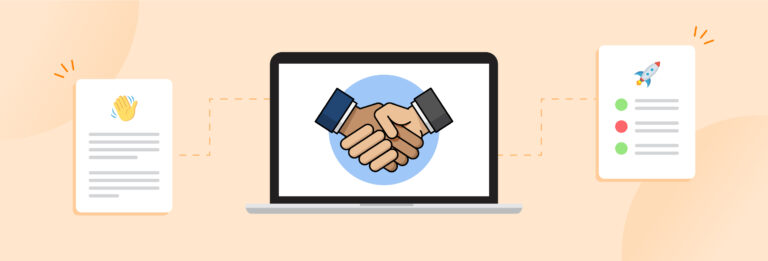Right after you’ve picked the right candidate from a barrage of applications, recruitment ends and onboarding starts. The employee onboarding stage is an extremely crucial one and it can make or break a new hire’s experience in an organization. As per research, new hires with a bad onboarding experience are more likely to leave the organization. So, what can you do to avoid this kind of a scenario?
For starters, have a proper employee onboarding process in place. And for that, you need to know the building blocks of a solid employee onboarding plan, one that can help you create an efficient system that creates productive employees that prove to be the organization’s assets.
In this blog, we have discussed the 5 building blocks of an efficient employee onboarding process. Let’s dig deep!
Why is it important to have a new employee onboarding process in place?

A recent survey from Glassdoor found that businesses having a strong onboarding process improve retention of new hires by 82% and increase productivity from workers by more than 70%.
Think of it this way — if a new person is coming to a new place, wouldn’t the person’s experience be defined by how well they are perceived at the new place and how well the people of the new place behave?
That’s exactly how the relationship between a new hire and the organization works as well. The initial few months of onboarding define the nascent stages of an employee’s experience, one that defines whether or not they are going to stick by the organization for the long haul.
Having a proper employee onboarding process flow is important for the following reasons
It makes the new employee feel welcome
Enhances the experience of the new employee
Helps new hires focus on the job at hand as the authorities take care of the formalities
Great onboarding experience establishes a good name in the hiring market
Reduces the attrition rate and increases the retention rate
Makes communication easier and faster
A strategic employee onboarding plan can helps you create a more personal and connecting system for onboarding remote employees, in case you have a hybrid setup or are in-between set-ups due to the disruption that the COVID-19 has brought along.
What are the 5 building blocks of an efficient employee onboarding process?

As per various dictionaries across the world, a building block means a basic and strong unit on which the rest of the process or product is built. The building blocks of an efficient employee onboarding process are the same, the solid starting steps that define the rest of the process and can help you deal with the employee onboarding challenges.
Here are the most important pillars or blocks that you should prioritize when creating an employee onboarding process for your organization.

Building a strong channel of communication
This is perhaps the most important leg, whether you have a remote working system or an in-office one. A new hire’s first communication is with the HR and that remains the same throughout the recruitment process, with a few rounds with the management. But, it is only after the offer letter acceptance that the actual communication with the team and departments begins.
This can be done with simple meetings, whether virtual or in-person, where the new hire can get introduced to the teams they are going to work with. Communication also includes a free way of words as far as employee queries are concerned.
While HR is the go-to person for this, a good way to go on about it would be to get employee onboarding software with an HR chatbot. The chatbot should be conversational and multicultural, making the employee feel comfortable enough to ask all the questions.
The bottom line is that communication is the most basic building block of any process, and employee onboarding is no different. Make sure you ease it on all fronts when the new hire joins.
Incorporating the company culture
Company culture is an important aspect of employee onboarding. You have to not only try to sync the new hire’s individual goals with that of the company’s vision and mission, but also make sure that the former understands what the organization stands for and how it works. A good part of acquainting the new hire with the company culture can be done via branding. Send them the company merch and make them a part of the branded activities. Mailing them company’s welcome card is also a good way to do it.
Instead of doing this separately every time you hire, you can also have a knowledge management system in place via an employee onboarding or employee experience software, where the entire company manual should be. These facts about the company should be regularly updated and the new hire and other employees should be able to access, retrieve and generate reports on the same.
Of course, this excludes information of sensitive nature. However, this would help the new hires a lot by giving them relevant and accurate information at their fingertips and would free up the HR’s time to dedicate it to more fruitful tasks.
Establishing interaction among team members
We agree that communication is an essential part of employee onboarding. But, who communicates? People do. These people are the employees of the organization, bifurcated into respective teams, managers, the HR, etc. The new hire has to interact with all of them at some point in their employee journey, preferably within the first few months when the onboarding takes place, to form lasting relationships and create lasting impressions.
A good way to do it would be by facilitating meetings between the new hire and the various departments that they would be interacting and working with. This should be accompanied by townhouse meetings where the top management and the other departments interact with each other.
This helps the new hire in two ways — one, it helps them understand the people better and nullifies the feeling of being new and lonely, second, it helps them know the culture better via the company’s people.
Introducing company software
If your organization believes in automation of various procedures, it is important to acquaint the employee with it during the onboarding phase. The important thing, however, is to ensure that the software as well as the training is easy and not intimidating. The purpose of the software is to make the task easier and not add to the learning pile.
The most common software training is with respect to the company’s HRMS and employee experience software that are equipped with information and various modules and functions. The new hire should be trained to use it. The more interactive the software, the better, as it would help the new hire learn instead of the latter running pillar to post with the doubts.
Employee experience software and employee onboarding software are also much in demand nowadays for easing the onboarding process. It has also become more relevant after the COVID-19 disruption, because of the need to hire remotely and stitch the new hire together with the dispersed team, to form a base that is emotionally and professionally intact.
Consider investing in technology that is engaging and personal, making the entire exercise fun and knowledgeable instead of tiring and tedious.
Actionable points, aka, an onboarding checklist
Now comes the most important building block of an efficient employee onboarding process flow, a checklist. This is one thing that has been a manual mandate for long. Having a checklist in place and ticking off the steps and tasks as and when they are achieved and abiding by the employee onboarding best practices remains an important aspect even in the technology-driven world.
Consider an employee onboarding software that not only defines and charts out the procedure and steps of onboarding for you, but also connects the steps to the respective people and sends out periodic reminders of the tasks that have to be done. For instance, whether it is sending the offer letter or conducting an induction meeting, having a software will make sure your checklist is not only complete on paper but also in deed – without any manual effort!
A few words before before wrapping up
Most of the organizations have an employee onboarding process in place. But, what matters is how efficiently you execute it. More importantly, is your onboarding process becoming more efficient and swift with time? If not, you need to identify the gap and address it.







6 Comments